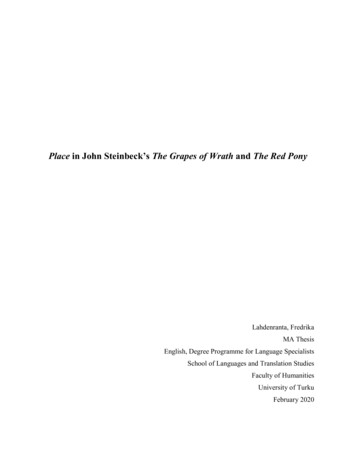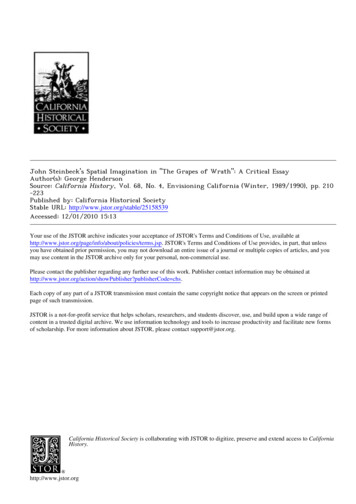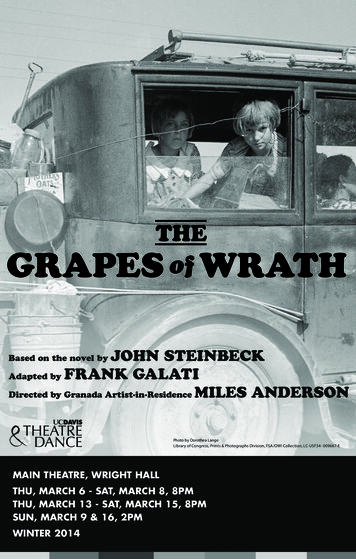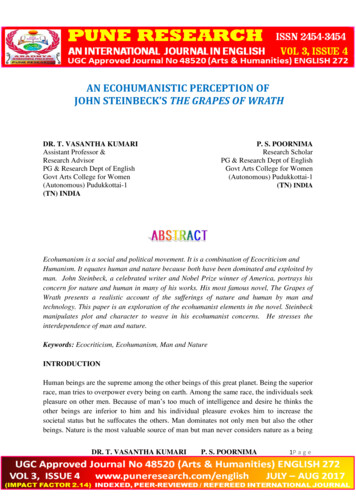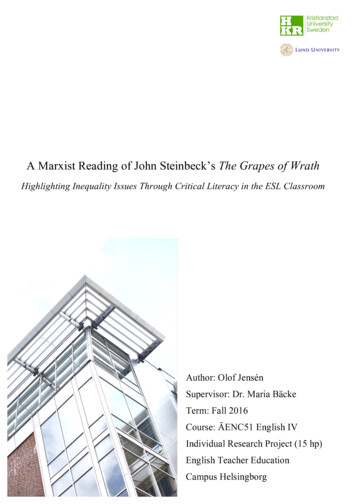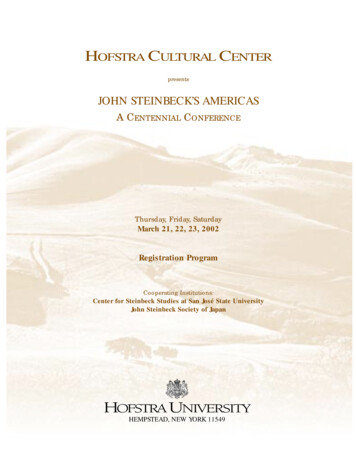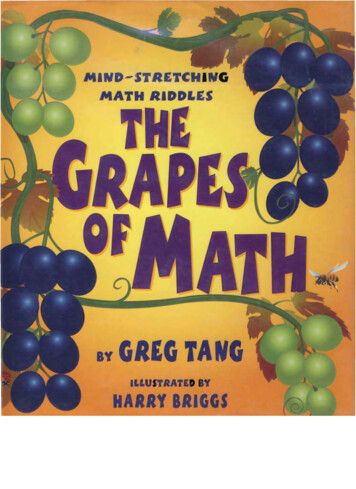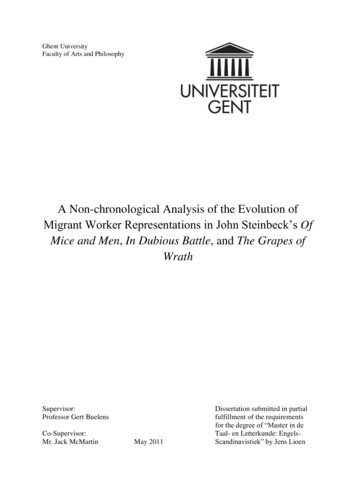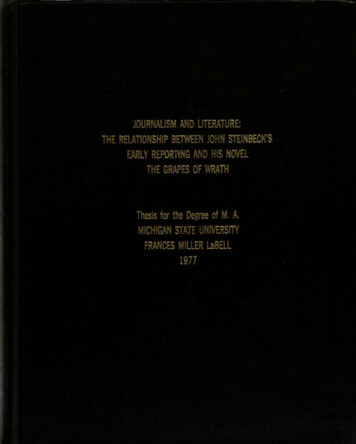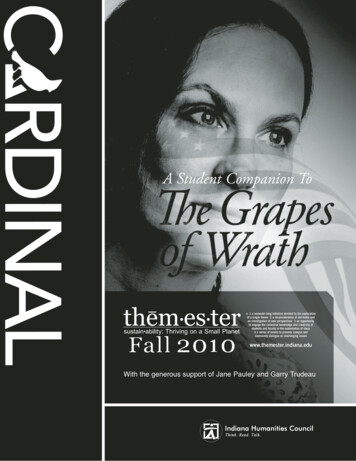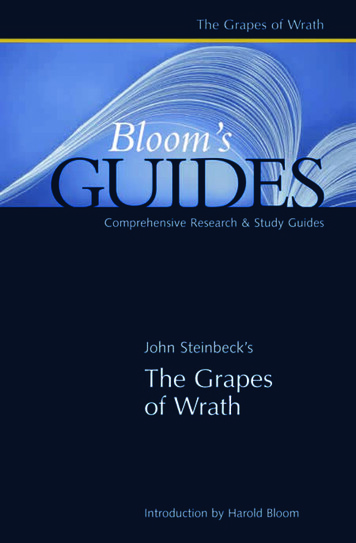
Transcription
Bloom’sGUIDESJohn Steinbeck’sThe Grapesof Wrath
CURRENTLY AVAILABLE1984The Adventures of Huckleberry FinnAll the Pretty HorsesBelovedBrave New WorldThe ChosenThe CrucibleCry, the Beloved CountryDeath of a SalesmanThe Grapes of WrathGreat ExpectationsHamletThe Handmaid’s TaleThe House on Mango StreetI Know Why the Caged Bird SingsThe IliadLord of the FliesMacbethMaggie: A Girl of the StreetsThe Member of the WeddingPride and PrejudiceRagtimeRomeo and JulietThe Scarlet LetterSnow Falling on CedarsA Streetcar Named DesireThe Things They CarriedTo Kill a Mockingbird
Bloom’sGUIDESJohn Steinbeck’sThe Grapesof WrathEdited & with an Introductionby Harold Bloom
2005 by Chelsea House Publishers, a subsidiary of Haights CrossCommunications. www.chelseahouse.comContributing editor: Sarah RobbinsCover design by Takeshi TakahashiLayout by EJB Publishing ServicesIntroduction 2005 by Harold Bloom.All rights reserved. No part of this publication may be reproducedor transmitted in any form or by any means without the writtenpermission of the publisher.Printed and bound in the United States of America.First Printing135798642Library of Congress Cataloging-in-Publication DataJohn Steinbeck’s The grapes of wrath / [compiled by] Harold Bloom.p. cm. — (Bloom’s guides)Includes bibliographical references and index.ISBN 0-7910-8239-3 (alk. paper)1. Steinbeck, John, 1902-1968. Grapes of wrath. 2. Migrantagricultural laborers in literature. 3. Rural families in literature. 4.California—In literature. 5. Labor camps in literature. 6. Depressionsin literature. I. Title: Grapes of wrath. II. Bloom, Harold. III. Series.PS3537.T3234G8557 2005813’.52—dc222004027519Every effort has been made to trace the owners of copyrighted material andsecure copyright permission. Articles appearing in this volume generallyappear much as they did in their original publication with little to noeditorial changes. Those interested in locating the original source will findbibliographic information in the bibliography and acknowledgmentssections of this volume.
ContentsIntroductionBiographical SketchThe Story Behind the StoryList of CharactersSummary and AnalysisCritical Views7Brian E. Railsback on Darwinism1015182346464750Malcolm Cowley on Steinbeck’s “Fight AgainstIntolerable Wrongs”52Frederic I. Carpenter on the Novel andAmerican Transcendentalism55J. Paul Hunter on the Bible and the Noveland the Characters of Jim Casy and Rose of Sharon57Stanley Kunitz on Vulgarity in the NovelJohn Ditsky on the Novel’s Last SceneNellie Y. Mckay on Social Change, the Redefinitionof Family, and MotherhoodWarren French on Steinbeck and ModernismStuart L. Burns on the Symbol of the TurtleEdwin T. Bowden on the Okies and IsolationMary Ellen Caldwell on Chapter 15 and the Epitomeof The Grapes of Wrath62656770Leslie Gossage on Discrepancies between Novel and Film7377Mimi Reisel Gladstein on Ma Joad’s Characterin John Ford’s Film80Works by John SteinbeckAnnotated 9395
IntroductionHAROLD BLOOMThe Grapes of Wrath is a flawed but permanent American book,and its continued popularity, after well more than half acentury, seems to indicate that it is anything but a period-piece.In the age of George W. Bush and his allies, the ChristianRight, Steinbeck’s prose epic has a fresh capacity to offend ourpillars of Society. Steinbeck’s Okies are detached by him fromtraditional Protestantism and believe instead in a curious butvery American religion of their own, in which the lapsedminister Jim Casy is a secular Jesus Christ and his survivor,Tom Joad, is a kind of St. Paul of social rebellion. ThoughSteinbeck’s prose is perpetually imbued with the King JamesBible (and Hemingway), Casy’s own Bible reduces to a singlebook, Ecclesiastes or the Preacher, the most skeptical writingthat is canonized as part of the Hebrew Bible or Christian OldTestament. Casy’s radical and naturalistic humanism has clearsources in Ralph Waldo Emerson’s vision of the Oversoul and inWalt Whitman’s love of the democratic masses, yet its darkerovertones derive from the tragic Preacher of Ecclesiastes. WhenJim Casy declares the holiness of human sexuality or ofbreakfast, he does not rely upon God as his authority, and TomJoad does not become an outcast prophet in the name of a Lordwho is trampling out the vintage where the grapes of wrath arestored. Tom Joad, American in his self-reliance, will stamp themout for himself, and for those dispossessed with him.As an American epic, The Grapes of Wrath never loses itspolemical edge, which is a populist rather than Marxist. TheEnglish novelist Anthony Burgess, who recognized shrewdlythat Hemingway was Steinbeck’s trouble, noted also thatSteinbeck was precisely what he asserted himself to be, aJeffersonian Democrat. I myself tend to think of Steinbeck asthe Harry Truman of American novelists: kindly, honorable,pugnacious, and opposed to all forces of exploitation. The7
shadow of Hemingway hovers over every descriptive passage inThe Grapes of Wrath, yet for once the book is wholly Steinbeck’sown. There is nothing of Hemingway in its stance towardsAmerica, though the prose filters the King James Bible’srhetoric through Hemingway’s mode of writing about theobject-world. As has been noted frequently by critics, thewomen of The Grapes of Wrath are stronger than the men,except for the prophets Jim Casy and Tom Joad, and yet theyare not the devouring women of Hemingway and of ScottFitzgerald. The endurance of Ma Joad and of Rose of Sharon isone of the ornaments of The Grapes of Wrath.Why should the best of Steinbeck’s women seem lessoverdetermined than the men, or quite simply, why does MaJoad have more freedom of the will than her son Tom does?Why are Steinbeck’s men more of a social group, their fatessettled by economics, when his outstanding women are able tomanifest an acute individuality? Is Ma Joad’s passion forkeeping her hard-pressed family together merely an instinctualreflex? Certainly, without her will and drive, Tom Joad wouldnot have had the desire to carry on for the martyred Jim Casy.One could argue that The Grapes of Wrath weakens as itapproaches its conclusion and that only Ma Joad keeps thistrailing-off from becoming an aesthetic catastrophe. Confusedas Steinbeck becomes, mixing allegorical and ironic elementsinto a previously realistic plot, the consistency of Ma Joad helpsthe novelist firm up an otherwise wavering structure. It iscurious that rereading the novel can be a less rewardingexperience than reseeing the film, where the young HenryFonda’s performance as Tom Joad compensates for some of thecontradictions built into the character. The achieved pathos ofFonda’s acting helps obscure Steinbeck’s inability to persuadeus that Tom Joad ends with a more fully articulated sense ofidentity than he possessed at the onset of the story.Steinbeck’s naturalistic humanism itself seems confused: dohis characters fall into animal-like behavior because of society’soppressions, or because they simply revert to their true identitywhen they are uprooted? Morale is a category that has validityin Hemingway, where you can show courage and assert your8
dignity against grave odds or else collapse into a failure ofnerve. Steinbeck, Hemingway’s involuntary disciple, generallycannot keep so dear a vision as to whether the human will issignificantly free or not. Ma Joad tells us that the people go on,despite all the injustices that they suffer; we come to believethat the Joads go on mostly because of her firm matriarchalwill. Perhaps Steinbeck’s true strength in this too-ambitiousnovel is that the spirit of Ecclesiastes is more movinglyincarnated in Ma Joad than in the prophets Jim Casy and TomJoad. She, and to a lesser extent Rose of Sharon, have theindestructible endurance that rises up from the wisdom of anultimate skepticism, one that expects nothing and so cannotknow defeat.9
Biographical SketchOn February 27, 1902, John Steinbeck was born in Salinas,California, the only son of John Ernst and Olive Steinbeck—aflour-mill manager and schoolteacher. After graduating fromhigh school in June of 1919, while the Great War was drawingto a close, he set out for Stanford University and quickly gaineda reputation for being a libertine. During the summers heworked in Salinas as a maintenance man and a ranch hand. Hedropped out of school during the middle of his sophomore yearand took a bus to San Francisco with Jack London-inspiredhopes of boarding a Far East-bound vessel. Soon enough,however, he realized his inexperience and lack of direction andreturned to the Salinas Valley. During his time back home,Steinbeck found odd jobs with which to sustain himself; in doingso he picked up material which he would later use in books suchas The Pastures of Heaven and The Long Valley. He reapplied foradmission to Stanford for the winter of 1923, and when he wasaccepted, he fell into a literary-minded crowd and published twostories in the Stanford Spectator before deciding that he hadendured “all of college I deserve” and needed to run away. In1925, Steinbeck became preoccupied with getting to New YorkCity—with the publication of Fitzgerald’s The Great Gatsby andthe lure of Greenwich Village adding to his impetus. His meansof travel was by way of a friend’s house on Lake Tahoe and thena job on a ship headed through the Panama Canal to New York.His uncle Joe helped him get a job at the New York American,though in time the lures of city life began to get the better ofSteinbeck, his work slackened, and his supervisors fired him. Heseized this opportunity to write a series of stories, which werelater rejected on the principle that short stories from anunknown writer were not marketable. Desperate for money, hetook a job as a steward on a freight ship to San Francisco, andreturned to California once again. On another trip to Tahoe hemet his future wife Carol Henning, and the nature thatsurrounded him fueled his interest in Thoreau and naturalismand inspired his first novel, Cup of Gold.10
In mid-January 1929, a wire came to announce that RobertM. McBridle & Company had accepted Cup of Gold forpublication. A year later he and Carol were married in ahaphazard, spur-of-the-moment ceremony; they rented a shackon the way to Laguna Beach for 15 dollars a month and set updomestic life and writing work among a close-knit circle offriends. That fall, in the waiting room of a dentist’s office,Steinbeck met Edward F. Ricketts, who would later serve as anintellectual companion and an inspiration for six novels,including The Grapes of Wrath. At Ricketts’ urging, Steinbeckexamined the dialogue of the fishermen, winos, andbusinessman who lived and worked along Cannery. The twowould sit up into the night and discuss philosophy of theindividual versus the collective. The Pastures of Heaven waspublished in November 1932, and Steinbeck’s Monterey wasexpanding to include mythologist and cultural scholar JosephCampbell, who had an affair with Carol.1933 brought trouble to the country and to Steinbeck,whose parents’ health declined, prompting his return toSalinas. To a God Unknown was published in the fall, andSteinbeck retreated into the composition of Tortilla Flat,avoiding his wife. He also published two sections of The RedPony in North American Review. Tortilla Flat’s initial rejectiondiverted Steinbeck’s attention to short stories, one of which,“The Murder,” earned the O. Henry prize. Around this timeSteinbeck became more and more involved with the situationof the migrant workers in the area and visited with severalprominent social reformers, including muckraker LincolnStevens and union leader Cicil McKiddy, who became aninspiration for the book In Dubious Battle and arguably forTom’s character in The Grapes of Wrath.Meanwhile, in Chicago, publisher Pascal Covici agreed topublish his work, including Tortilla Flat, which appeared fivedays after Steinbeck’s father’s death. The firm Covici-Friedepublished In Dubious Battle in early 1936, and Steinbeck beganwork on Of Mice and Men. That summer, he agreed to write aseries of pieces for the San Francisco News about migrantfarmers in California, “The Harvest Gypsies.” Of Mice and Men11
was published during the winter of 1937; it was adapted into aplay by George S. Kaufman, which opened to great reviews thefollowing February. He finished the novella L’AffaireLettuceberg, a precursor to The Grapes of Wrath, in late April1938, burned the manuscript and began anew in May, keepinga diary of his work. Soon after he published The Long Valley—abook of stories, the last of which is part of The Red Pony—hefinished The Grapes of Wrath. The exposure surrounding thispublication piqued Hollywood interest, and Steinbeck movedto Los Angeles. There he tried to escape marital problems andbegan an affair with young Gwendolyn Conger. The Grapes ofWrath became the best-selling book of 1939 and garnered thePulitzer Prize shortly thereafter. Steinbeck, Ricketts, Carol,and others embarked on a trip to study the coastal waters offSan Francisco and the shoreline of Baja California. The resultwould be the Sea of Cortez, published in 1941. In themeantime, Steinbeck worked for Hollywood and met withPresident Roosevelt to suggest a propaganda effort to unitethe antifascist nations.Steinbeck left Carol—and California—to set up a life on theEast coast and set to work on his next novel, The Moon is Down.More wartime projects followed, including Bombs Away: TheStory of a Bomber Team, and the scripts A Medal for Benny andLifeboat. Steinbeck and Gwendolyn—Gywn—were married inMarch 29, 1943, and soon after, he took the opportunity towork overseas as a war correspondent. Thom Steinbeck wasborn in New York in August, and Cannery Row was published inJanuary 1945, as the Battle of the Bulge was drawing to a close.John Steinbeck IV was born in June of 1946, and the dotingfather continued to work furiously in his basement, dictatinginto a tape recorder. The Wayward Bus appeared in 1947, and atrip to Russia with photographer Robert Capa resulted in thepublication of A Russian Journal the following year. WhileSteinbeck was in Russia, The Pearl was released, simultaneouslyas a book and movie.After his return from Russia, Steinbeck learned that EdRicketts was killed in a car accident. Gwyn asked for a divorceand began what would be a long struggle over children and12
money. Distraught and unable to focus on his big novel heturned his attention toward an Emiliano Zapata film project,spearheaded by Elia Kazan. He was elected to the Academy ofArts and Letters, and he began seeing Elaine Scott, a formeractress and stage manager; she introduced Steinbeck toRogers and Hammerstein, who bought the rights to a newplay Steinbeck was working on, Burning Bright. Elaine andJohn were married on December 28, and Steinbeck returnedfrom his honeymoon dedicated to working on East of Eden—afamily history for the benefit of Thom and John. While inSpain with his wife Steinbeck heard that Kazin had testifiedbefore the House Committee on Un-American Activities, andhe defended his friend. After visits to Italy, France, andEngland, they flew back to New York right before thepublication of East of Eden. It immediately climbed to the topof the New York Times bestseller list. In 1955, after therelease of Sweet Thursday, by Rogers and Hammerstein,Steinbeck began working as editor-at-large at SaturdayReview. His play Pipe Dream opened on Broadway, and whenhe finished The Short Reign of Pippin IV he told his editor thathe wanted to retell the Knights of the Round Table inEnglish, effectively recasting Malory. He and Elaine lived andworked in Somerset, England, for awhile, and returnedreluctantly to New York in 1959.After so much time abroad, Steinbeck set off on a zig-zagtour of the country in 1960, which resulted in Travels withCharley. He and Elaine took his boys on a trip around theworld, and were accompanied by a young Irish playwrightnamed Terrence McNally. Steinbeck’s ill health cut the tripshort, and though they hoped things would calm down,Steinbeck journeyed to Stockholm later that year to accept theNobel Prize for literature. The Steinbecks continued travelingand were in Warsaw when they learned that Kennedy was shot;later Mrs. Kennedy wrote to Steinbeck asking if he’d write theofficial biography of her husband. They exchanged letters backand forth, but eventually Steinbeck said that he wouldn’t beable to do such a thing. Steinbeck appeared at the WhiteHouse to receive the Presidential Medal of Freedom in13
September of 1964, and Johnson asked him for help on hisacceptance speech at the upcoming Democratic convention.This friendship he sustained until the end of his life, though hewas torn between logic and his loyalty to the president duringthe Vietnam War. Newsday sent him there as a warcorrespondent, which led to his “Letters to Alicia.” Hereturned with a serious back injury and confusion about how hemight explain his feelings about the war to President Johnson.His health only declined from there, and he passed awayquietly, Elaine by his side, on December 20, 1968.14
The Story Behind the StoryJohn Steinbeck’s long journey with The Grapes of Wrath beganduring the fall of 1933, when he took long walks aroundSalinas, to gain relief from the stresses of caring for his dyingparents. There he encountered the beat-up cars fromOklahoma, stacked to the hilt with furniture and otherpossessions and bound west. One day Steinbeck visited ashantytown outside Salinas, which had been dubbed “LittleOklahoma” by the locals, and heard the people’s stories.“There’s a novel here somewhere,” he later told his wife,Carol. (Benson, 286) Though several novels were to comefirst, Steinbeck’s fascination with the plight of the migrantfarm workers would continue through the end of the decadeand beyond. Indeed, it was difficult for a resident of theCalifornia’s Central Valley to ignore the influx of people to thearea—by the end of the decade, the number of Dust Bowlrefugees had been estimated at three or four hundredthousand. (Benson, 335)During August 1936, not long after the publication of InDubious Battle, Steinbeck was visited by George West, an editorof the San Francisco News, who commissioned him to write aseries of pieces about the migrant farmers in California.Steinbeck immediately began his task, driving his “piewagon”—an old bakery truck—in order to look asinconspicuous as possible. He worked with officials of thegovernment’s Resettlement Administration, and spent a gooddeal of time in the San Joaquin Valley with regional directorEric H. Thomsen, who wanted to show him the differencebetween migrants’ quality of life in government camps and ontheir own. In Maryville Steinbeck encountered Tom Collins,the manager of one of the first Resettlement Administration“demonstration camps,” designed to be used as blueprints forgrowers and local government. Collins inspired Steinbeck soprofoundly that The Grapes of Wrath was dedicated in part “ToTom, who lived it.” Collins, who wore a frayed white suit, likethe novel’s character Jim Rawley, kept extensive documentation15
of his experiences in the camps, from the hardships to theentertainment, and such reports informed much of Steinbeck’swriting.Steinbeck finished the seven pieces for the News, each onedealing with a different aspect of the migrant experience andcollectively titled “The Harvest Gypsies.” After the hubbubsurrounding Of Mice and Men’s Broadway debut died down, thewriter planned a journey west along Route 66, tracing themigrants’ path and hooking up with Collins in Gridley, wherehe was working. By midwinter he was at work on The Grapes ofWrath, taking occasional trips back to the camps, including aLife magazine commissioned trip to the Visalia region, where aflood brought about starvation and sickness beyond Steinbeck’sscope of imagination. The Simon J. Lubin society reprintedSteinbeck’s News articles in a pamphlet entitled Their Blood isStrong, which drew further attention to the scope of theproblem in California.Steinbeck’s interest in the Salinas lettuce strike of 1936 andhis anger at the entire situation fueled the completion ofL’Affaire Lettuceberg, which many consider to be a “dry run” forThe Grapes of Wrath. Steinbeck himself did not have faith in thenovella, which satirized the banks and other anti-labor forceswho threatened the migrant workers. His wife Carol, whodescribed it as a “series of cartoons caricaturing Salinas fatcats,” (Benson 348), suggested he burn it. Burn it he did, andhe began in mid-May, alternating chapters of exposition andnarrative, and working furiously. The new title of the book, TheGrapes of Wrath, was decided upon in September of 1938—itwas taken from the Battle Hymn of the Republic. He finished thebook in late October, consumed by sickness and hoping he’dachieved something “good.”Steinbeck’s editor, Pat Covici, wrote that he was“emotionally exhausted upon finishing the work,” but theending he found highly controversial. Debate about this scene,and the decisions Steinbeck made therein, continues today.Critic Nicholas Visser deemed “radical” Steinbeck’s choice: thecharacter Rose of Sharon, after having given birth to a stillbornbaby, which is sent down the river in an apple box, holds the16
head of a starving man of her breast, in an attempt to share themilk of human kindness. Despite the disputes over the image ofthis character as a modern Madonna, Steinbeck insisted thatthis image had been with him from the novel’s outset, and thatthe strangers the Joads encounter toward the end could notpossibly be integrated earlier.When The Grapes of Wrath was first published, it wasreceived more as historical documentation and as popularreading matter than work of true literary merit. Though it hasmany influences—the Biblical structures and the interchaptersreminiscent of works by writers as contemporary to Steinbeckas John Dos Passos—the structure is somewhat unique. Criticssuch as Kenneth Burke, Edmund Wilson, and Frederic J.Hoffman thought the novel dishonest. It was criticized as wellfor its lack of organization and its unrealistic dialogue.According to Steinbeck scholar Peter Lisca, these responseswere more assertive than analytical. For the topic was likely tooclose to them, and the presentation too universal, for critics toconsider this a work of literature instead of one of socialcommentary. Indeed, Alfred Kazin called the book “The mostinfluential social novel of the period.” But again, this statementof praise does not necessarily mean that he celebrated thefictive qualities of the work; in fact, in the same essay, hedeemed its characters unrealistic. Still, the endurance of thebook that Lisca called “a great American novel in every sense ofthe phrase,” is undeniable. In the United States alone, 50,000copies are sold every year.17
List of CharactersTom Joad: The central character of the novel, Tom Joad, arecently released inmate imprisoned for murder, returns hometo find that his family has lost their farm and is moving west toCalifornia. Tom is a well-meaning man, but he has quick,passionate, and sometimes violent reactions. As his familystruggles to survive in worsening circumstances, Tom focuseshis energy on helping to organize and help those migrantfamilies in need.Ma Joad: In some ways the strongest character in the novel,Ma Joad is mother to Noah, Tom, Rose of Sharon, Ruthie, andWinfield. Her love is not demonstrated by acts of affection, butby pragmatism, plain speech, and an unshakable willingness tohelp those less fortunate. She often places herself inuncomfortable situations for the benefit of the family; as thesituation in California worsens, she realizes that the meaning of“family” actually encompasses all of mankind.Pa Joad: The head of the Joad household, Pa is an Okalahomasharecropper who has been evicted from his farm. He’s a plainspoken, hardworking man with a spark of mischief, but as thenovel progresses, he is frustrated by his inability to control thesituation for his family. He is forced to rely on Ma Joad to steerthe family and to take a hard line, and this reversal of genderroles frustrates him.Uncle John: When the Joads first lose their farm, they seekshelter with Pa’s brother John, who lost his wife toappendicitis after only four months of marriage; the guilt hefelt then has been transferred to a feeling of responsibility forall the family’s problems. He is often a morose addition to thecaravan West, oscillating between severe self-denial anddangerous indulgence. “He ate little drank nothing, and wascelibate,” Steinbeck writes. “But underneath his appetitesswelled into pressures until they broke through. when one18
of his appetites was sated he was sad and ashamed and lonelyagain.” (124)Rose of Sharon: Tom Joad’s younger sister, recently married toConnie Rivers and pregnant with his child, Rose of Sharonbegins the journey West with an almost childlike sense ofoptimism in the future. “The world was pregnant to her,”Steinbeck writes. “She thought only in terms of reproductionand motherhood.” (123) She dreams constantly of a middleclass life with her husband and her baby, but when her husbandleaves her with no warning, she becomes more and moreparanoid and disillusioned.Connie Rivers: The nineteen-year-old husband of Rose ofSharon, he is ambitious and irrational, and regards his youngwife with pride, greed, and fear. Connie dreams of takingcorrespondence courses that will provide him with jobopportunities and the possibility of a better life, and hepromises Rose of Sharon comfort, cleanliness, and adequatehealthcare for their newborn. But when he finds the scenario inCalifornia much worse than he expected, he simply disappearsfrom Rose of Sharon’s life forever.Noah Joad: The eldest of the Joad children, Noah is “tall andstrange, walking always with a wondering look on his face, calmand puzzled. He had never been angry in his life . movedslowly, spoke seldom . people thought he was stupid.” (101)This “strangeness” was perhaps the cause of an incident atbirth, when Pa, a frightened young father, attempted to extractthe baby’s head using force. Noah leaves the family at theCalifornia border, content to remain an outsider and live offthe land—he leaves the burden of explanation to Tom.Al Joad: Tom’s younger brother, Al is a gifted mechanic anddreams of owning his own garage one day. He’s equally drawnto young girls. As his family’s situation worsens, he is oftenunable to reconcile necessary sacrifices, such as giving up meatin order that one of his brothers and sisters might benefit from19
another crucial foodstuff. Since he has the most knowledge ofthe family’s sole means of transportation, he worries that hewill be to blame if something goes awry. By the end of thenovel he becomes engaged to Aggie Wainwright, and Maworries that the two will attempt to make their way alonebefore spring comes to California.Ruthie Joad: Tom’s twelve-year-old sister is tomboyish andforceful, though she “felt the might, the responsibility, and thedignity of her developing breasts.” (123) One afternoon fightover a box of Cracker Jack results in Ruthie’s admission thatTom is responsible for the murder at Hooper Ranch—this slipforces him to leave the family to avoid the police.Winfield Joad: The youngest of the Joad clan, ten-year-oldWinfield is “kid-wild and calfish . a trifle of a snot nose, alittle of a brooder back of the barn, and an inveterate collecterand smoker of snipes.” (123) When the family struggles tofeed themselves by picking peaches at the Hooper Ranch,Winfield becomes severely ill from deprivation, though somehard-won milk from the ranch store sets him on the road torecovery.Grampa Joad: Pa Joad’s father, Grampa is “like a frantic child,and the whole structure overlaid with amusement . he dranktoo much, ate too much, talked too much.” (100) His pride inhis family’s heritage on the farm results in a protest so forcefulthat the family must drug him to get him onto the truck. Oncethe journey commences, he quickly becomes ill, and he dies ofa stroke before they even cross the Oklahoma border.Granma Joad: Her husband’s equal in so many ways, GramnaJoad “had survived only because she was as mean as herhusband. She held her own with a shrill ferocious religiositythat was as lecherous and as savage as anything Grampa couldoffer.” She often implores Jim Casy, a former preacher, to prayfor her family; after her husband’s death her health quicklydeclines—she dies just as the family crosses into California.20
Reverend Jim Casy: The former town preacher who has losthis faith as a result of temptation, Jim Casy encounters a justfreed Tom Joad under a willow tree and immediately beginsdiscussing his idea that holiness comes from collective society.His gratitude toward the Joads is so great that when a fightbreaks out in the Hooverville, Casy takes the fall for the Joads.Tom later encounters Casy among labor organizers outside aranch, and later that night, Casy is murdered in a confrontationwith police.Muley Graves: Muley Graves’s wife and children leaveOklahoma for California after they lose their home andfarmland, but Muley decided to remain in the place he wasborn, lurking in the carcasses of the farmhouses like a“graveyard ghost” and attempting to elude the police for hisconstant trespassing. After Tom leaves prison he encountersMuley on his family’s property, and Muley tells Tom of hisfamily’s misfortune and whereabouts.Sairy and Ivy Wilson: After the Joads encounter her family inBethany, Oklahoma, Sairy does her best to comfort them asGrampa sickens and eventually passes away. But Sairy herself issick, her “face wrinkled as a dry leaf and eyes that seemed toflame in her face, black eyes that seemed to look out of a wellof horror. She was small and shuddering.” (172) She and Ivy, amiddle-aged man from Galena, Texas, accept the Joads’ offe
Steinbeck met Edward F. Ricketts, who would later serve as an intellectual companion and an inspiration for six novels, including The Grapes of Wrath. At Ricketts’ urging, Steinbeck examined the dialogue of the fishermen, winos, and businessman who lived and worked along Cannery. The two
